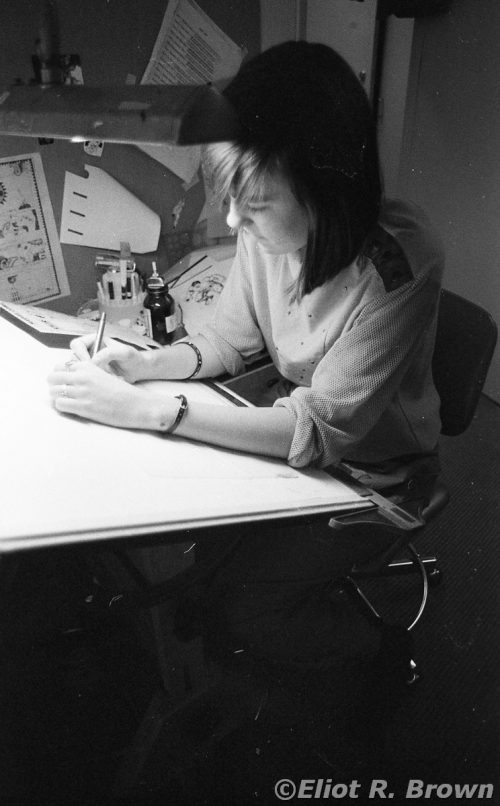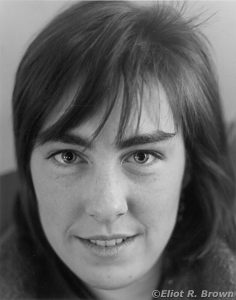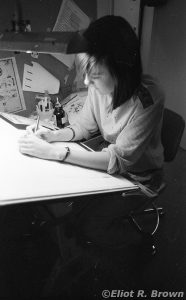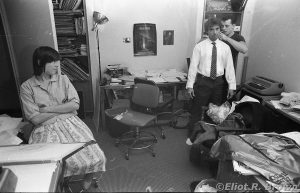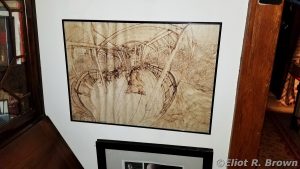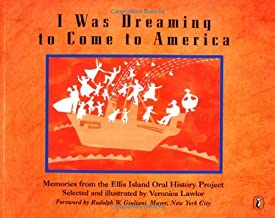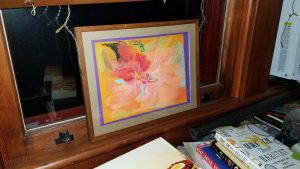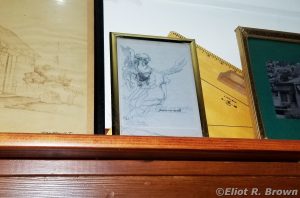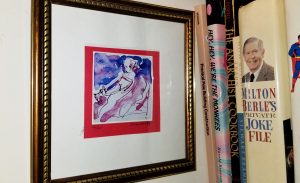Hello and welcome to an Interview from Behind the Universe!
Today we have the amazing Veronica Lawlor joining us for a chat.
Veronica has been
doing reportage (on the spot, real time drawings of significant people and
events) and illustrations for decades now, even doing a portrait of Pope John
Paul the Second which is probably the best resume mic drop I have ever seen.
She is also a member of Studio 1482 which is a group focused on reportage and dedicated
to finding new and imaginative ways to create visual art.
But before hitting the Painting the Pope levels, she was an Assistant Editor for Marvel back in the 80s then worked in the Special Projects division where she teamed up with Eliot and Jack Morelli doing odd technical jobs around the office.
She was only at Marvel for six years but more than enough time to make an impression. Keep reading till the end and you can see the original Lawlor art we keep in the living room.
Q. When you started off at marvel, you were the assistant of Christopher Priest (Once known as Jim Owsley). That is very cool! How did that happen?
The story of how I got started working for Jim Owsley at Marvel is super convoluted and fun. I was a sophomore at Parsons School of Design in the illustration department, and although I was doing well with drawing and painting, I was having difficulties in my illustration classes. This was the mid-80s, and the prevailing styles at the time were either super realism or surreal-like concept illustration. I didn’t jive with either of them, and was thinking about how I would pay my rent after graduation. I did well in my English literature electives and enjoyed them; I spoke with one of my professors to see what he knew about working in the editorial side of publishing. That seemed like it might be a good avenue for me to pursue.
The professor told me that a friend of his named Larry Hama knew someone who was looking for an assistant editor at Marvel comics, and would I like to go interview for the position? Of course I said yes!
Turns out that the interview was with Jim Owsley, for an assistant editor position working on the Spider-Man comics. As I remember it, Jim was kind of puzzled during my interview. He asked if I was a comic book fan, and I replied that I’d read Brenda Starr and Archie Comics a little bit as a child, and had watched the Spider-Man cartoons, but other than that, I didn’t really follow them. He asked if I was studying illustration to be a comic book artist, and I said no. Then he asked me what my long-term aspirations at Marvel Comics were, and I told him that I could only work for the summer, since I had to go back to school full time in the fall. I was so honest and naive! Jim was very nice but told me that he was really looking for someone who was interested in making a career in comics, which of course made sense. I left the offices sure that I would keep waitressing that summer. A week or so later, Jim called me. He’d found the perfect assistant editor, Maddie Blaustein, but she could not start until September. Would I like to be the assistant editor until then? Uh, yes please!
Crazy, huh? The worst job interview I did ever, brought me into the best job ever, and working at Marvel changed my life, in so many ways.
(fun trivia, Maddie Blaustein was the voice of Meowth in the early Pokemon cartoons! -Ed)
Q. What was your work before Marvel Comics and did that help prepare you for Marvel?
Before I worked at Marvel, I held all kinds of jobs while going to school. I worked as a cashier in a drug store, a waitress at a pizzeria restaurant, and briefly, as a stylist for a photographer on LI who specialized in sexy photos for housewives to give to their husbands. (I helped them pick out the best feather boas for their skin tones and such.) None of these jobs really helped me prepare for a job at Marvel Comics. It was such a fluke that I was hired, as I mentioned in my previous answer. However, since at the time I wasn’t too confident that I’d get work as an illustrator, I’d asked a fellow student at Parsons to teach me how to do paste-up and mechanical work, and I’d taken a few type classes as electives – it seemed like I’d be more likely to pay my rent with that. So, those skills prepared me for the freelance/part time job in Special Projects that I was eventually offered by Jack Morelli; once Maddie Blaustein became the Spider-Man assistant editor.
Ronnie at her desk in the Marvel Special Projects Office, 11th Fl of 387 Park Ave, NYC c.: 1985
Q. Do you have any stories from the Bullpen that you would like to tell? Perhaps something Eliot has overlooked in his writings or that you would like to add.
One strong memory I have from the Marvel bullpen happened after one of the holiday parties. A bunch of us left the party together, and when we exited the building on Park Avenue South, we saw that it had started snowing. So we had a huge snowball fight! We were all such kids, and we had such a great time playing in the snow together, surrounded by the streetwalkers that frequented the area at night in those days. It’s one of those kinds of golden memories that linger in my mind. Every time I see it snow in Manhattan I think of that snowball fight.
Ragtag Misfit 1) Veronica Lawlor, Misfit 2) Bob Harras, Misfit 3) Jack Morelli
Q. You, Eliot, and a ragtag group of misfits were in the Special Projects Department and some of the projects were the In-House Ads, so I’m told but the rest is a mystery to my old man despite him being in charge. Do you remember what the story was behind that department? And what was it like working there?
The Special Projects department seemed, to me, to be about doing all the odds and ends things that no one could really classify. I remember sitting in a tiny office at a drafting table that faced Jack Morelli’s drafting table. Eliot had a desk in that same office. It was like our little clubhouse. I know I did a lot of paste-up and mechanical work for the ads during that time. This was pre-computer era. I loved doing mechanicals by hand, you would line everything up with a T-square and a triangle, and paste it on to an illustration board to be photographed for publication. It’s kind of a lost art. To me, it was an unbelievable thing – I remember making $12 an hour doing paste-ups, and previously I’d worked as a waitress for $12 per night plus (crummy) tips. I felt like I was super-rich! I do remember though, dreading when I had to mount big posters on illustration board for conventions or what not. I was clumsy and not too smooth with the rubber cement- I’d panic at every little air bubble that got in between the paper and the board. Ugh.
Q. What was the most fun you had working on a project at Marvel?
I don’t remember any specific project that I worked on at Marvel, but I remember always asking for more graphic design work as opposed to straight up production. I used to like working with Carl Potts, because he’d encourage me to try unusual type treatments or hand-lettering in the designs, which was fun.
Q. How do you feel about the ways the comic industry’s process has changed over the years with the increasing shift towards digital work? Has that impacted your own art process?
I am a fan of digital tools because of how much capability they can bring to the artist, but I’m not always a fan of the digital look. In other words, when the program dictates the aesthetics as opposed to the artist/designer using the program to fulfill their own aesthetic vision, I’m not on board. I remember thinking that the “programmy” look was dominating comic books for a while in the 90s – super slick logos, weird textures, etc. – I thought that it was pretty ugly, to be honest. But now digital has become an integral part of comics, as well as other areas of the graphic arts and storytelling, and it’s a great asset.
[I originally thought this was a boat on the River Styx– turns out it’s the Mark Twain Riverboat Ride down at Disneyland! I love this piece a lot– that’s Ronnie’s own framing by the way– Mouse-Adoring Brown]
Even though the basis of my own art and illustration has been and continues to be analog work, I use digital tools all the time and draw with the computer. Recently I completed a series of illustrations for an interactive game installation that was created with Unity, and it was an awesome experience.
Q. My parents are huge fans of your work and I can really see it now that I look through your work. We have one of your first books downstairs, I was Dreaming About Coming to America Memories from the Ellis Island Oral History Project. Can you tell us how that project came about?
My book, I Was Dreaming to Come to America, Memories of the Ellis Island Oral History Project came out of artistic study. At the time the book was created (1994) I was drawing a lot on location – still the basis of everything I do – and I was also taking a lot of workshops with a teacher named David J. Passalacqua. He took us all over New York City to draw, and one of the locations we visited was the newly opened Ellis Island Immigration Museum. I remember being emotionally moved by the part of the exhibit where you could listen to recordings from the oral history project, and hear people’s experiences of coming to America through Ellis Island. I was also thinking about American folk art quilts, and how the immigration experience of this country is like a patchwork quilt. So I started designing ideas for quilt squares illustrating the oral histories with cut paper – and these became the illustrations for the book. I wasn’t really looking to create a children’s book, it grew very organically out of my artistic exploration. What’s interesting is that the illustrations for that book are not the style of work that I am most usually asked to create for commissions, but it’s a style that I keep coming back to in my career, depending on the project.
- ISBN-10 : 0140556222
- ISBN-13 : 978-0140556223
Q. What are your favorite experiences on the convention scene? Either as a professional or attending for fun.
My early convention scene experiences are not the norm: I first attended comic book conventions as somewhat of an insider, since I was married to Mike Carlin at the time. I mostly enjoyed the hanging out that surrounded the conventions – meeting the creators at dinners or parties. The first and only time that I went to the San Diego comic con, my favorite part was going to the beach near the Coronado Hotel and Tijuana with a group of professionals – I remember Mark Gruenwald, Archie Goodwin and his wife Anne Murphy, David Wohl and I think Marc Siry were there, probably a few more people too. Mike didn’t come with us, he was working at the convention. The London convention was a fun one too – they all were, really. It was because of comic book conventions that I first traveled outside of the US; the last one I went to with Mike (we’ve been divorced for years) was in Sydney, Australia!
Q. What has your career been like after Marvel?
My career after Marvel has been wonderful. I feel so lucky that I was able to continue to study reportage drawing after graduating from Parsons, and eventually began to do work that I love. I’m still doing it! The Ellis Island book was my first published illustration project, but in about 2000 I acquired an agent who helped my get my first jobs as a reportage illustrator, and I’ve continued to work in that area since. I also began teaching drawing and illustration at Parsons and Pratt at about that time, and I continue to teach at both schools, in addition to teaching my own location drawing workshops.
My time at Marvel taught me so much – sitting in those editorial meetings as an assistant editor taught me a lot about narrative structure and plot/character arcs. I also learned a LOT about sequential storytelling and storyboarding, which I’ve done a fair amount of in my career. And of course, my graphic design skills improved through the on-the-job training. The experience was amazing. I only worked at Marvel (and then DC) for about 6 years, but I learned so much during that time, that has helped me on my journey of illustration and education ever since. I’m so glad that Maddie Blaustein had something else to do in the summer of 1985!
[Ronnie would send hand-made Christmas Cards — shaming the rest of us with their meaning, content and heart– urr, effort. Little did she know that we would co-opt them as original pieces of art throughout the house– Opportunist Brown]
Q. Is there anywhere our readers can find you on social media or otherwise to keep up with you?
OK, here are a bunch of links.
You can find my illustration portfolio at Studio 1482: www.studio1482.com/veronica
My painting/personal work is at www.veronicalawlorgallery.com
My instagram is @verolawlor and @verolawlor_illustration
My blog site is www.veronicalawlor.com
I’m also on Facebook @veronicalawlorillustration, in case you got through all of those other links and aren’t sick of me yet!
Thank you very much for your time and effort here, Veronica.
I absolutely love this one, it’s refreshing to see Marvel from the perspective of someone not fully indoctrinated into the comic book life. Comic books are a glorious but small part of the art world, and it makes me happy seeing the Bullpen be part of someone’s journey into that world. It really speaks to the community that grew out of that office.
Something about that snowball fight really hit home for me, I wish we had some photos of that but sadly Eliot only had so many rolls of film.
And as promised, here are the Lawlor originals the Puentes-Brown household keeps in the living room just in case we ever need to hold a fancy cocktail party. [Nah, I sprinkled them through the article, nicer that way– forgive me, son– Aesthete Brown]
She really is damn talented, make sure you check out some of those links!
I hope everyone is staying safe and well!
Be seeing you,
-Nicholas Brown
